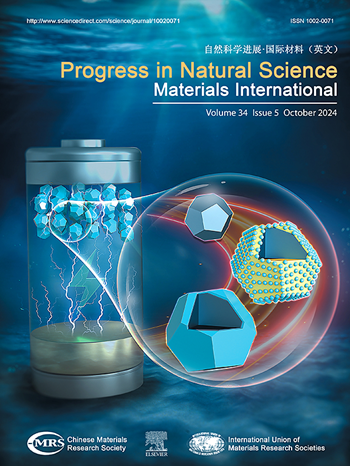Glass formation, structure, relaxation, and property of metal-organic framework (MOF) glasses: A review
IF 7.1
2区 材料科学
Q2 MATERIALS SCIENCE, MULTIDISCIPLINARY
Progress in Natural Science: Materials International
Pub Date : 2025-02-01
DOI:10.1016/j.pnsc.2024.12.006
引用次数: 0
Abstract
Metal-organic framework (MOF) glasses have emerged as a novel fourth class of inorganic-organic hybrid glasses, separate from traditional inorganic, organic, and metallic glasses. They exhibit unique properties and hold significant potential for diverse applications. In this review, we provide a comprehensive summary of the systematic classification, glass-forming methods, structure, and relaxation. Additionally, we present an extensive examination of various properties such as mechanical features, optical characteristics, and thermal transport aspects; as well as applications encompassing gas absorption and separation, ion transport, catalysis, and phosphorescence. Notably, a focused examination of recently reported novel carboxylic MOF glasses, in conjunction with previously unaddressed studies on relaxation dynamics and thermodynamics, serves to emphasize the significant challenges encountered by MOF glasses while simultaneously highlighting promising opportunities.
金属有机骨架(MOF)玻璃的形成、结构、弛豫和性能综述
金属有机骨架玻璃(MOF)是继传统无机玻璃、有机玻璃和金属玻璃之后,又一种新型的第四类无机-有机杂化玻璃。它们表现出独特的特性,在各种应用中具有巨大的潜力。在这篇综述中,我们提供了系统的分类,玻璃形成的方法,结构和弛豫的综合综述。此外,我们提出了各种性质,如机械特性,光学特性和热输运方面的广泛检查;以及应用包括气体吸收和分离,离子传输,催化和磷光。值得注意的是,对最近报道的新型羧基MOF玻璃的重点研究,结合之前未解决的弛豫动力学和热力学研究,有助于强调MOF玻璃遇到的重大挑战,同时也突出了有希望的机会。
本文章由计算机程序翻译,如有差异,请以英文原文为准。
求助全文
约1分钟内获得全文
求助全文
来源期刊
CiteScore
8.60
自引率
2.10%
发文量
2812
审稿时长
49 days
期刊介绍:
Progress in Natural Science: Materials International provides scientists and engineers throughout the world with a central vehicle for the exchange and dissemination of basic theoretical studies and applied research of advanced materials. The emphasis is placed on original research, both analytical and experimental, which is of permanent interest to engineers and scientists, covering all aspects of new materials and technologies, such as, energy and environmental materials; advanced structural materials; advanced transportation materials, functional and electronic materials; nano-scale and amorphous materials; health and biological materials; materials modeling and simulation; materials characterization; and so on. The latest research achievements and innovative papers in basic theoretical studies and applied research of material science will be carefully selected and promptly reported. Thus, the aim of this Journal is to serve the global materials science and technology community with the latest research findings.
As a service to readers, an international bibliography of recent publications in advanced materials is published bimonthly.

 求助内容:
求助内容: 应助结果提醒方式:
应助结果提醒方式:


